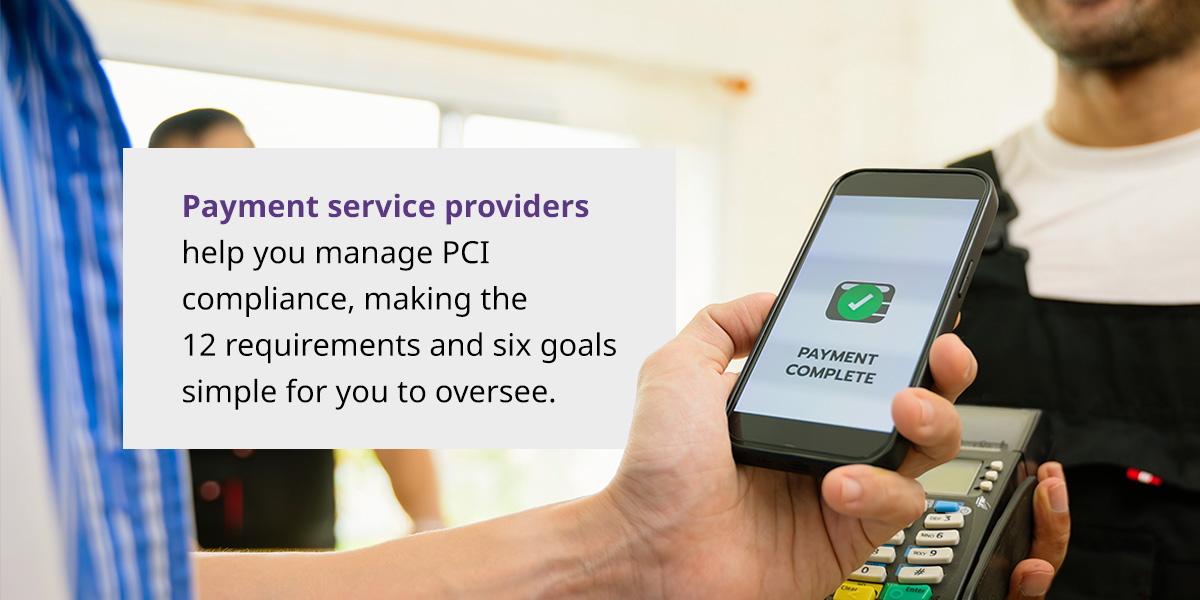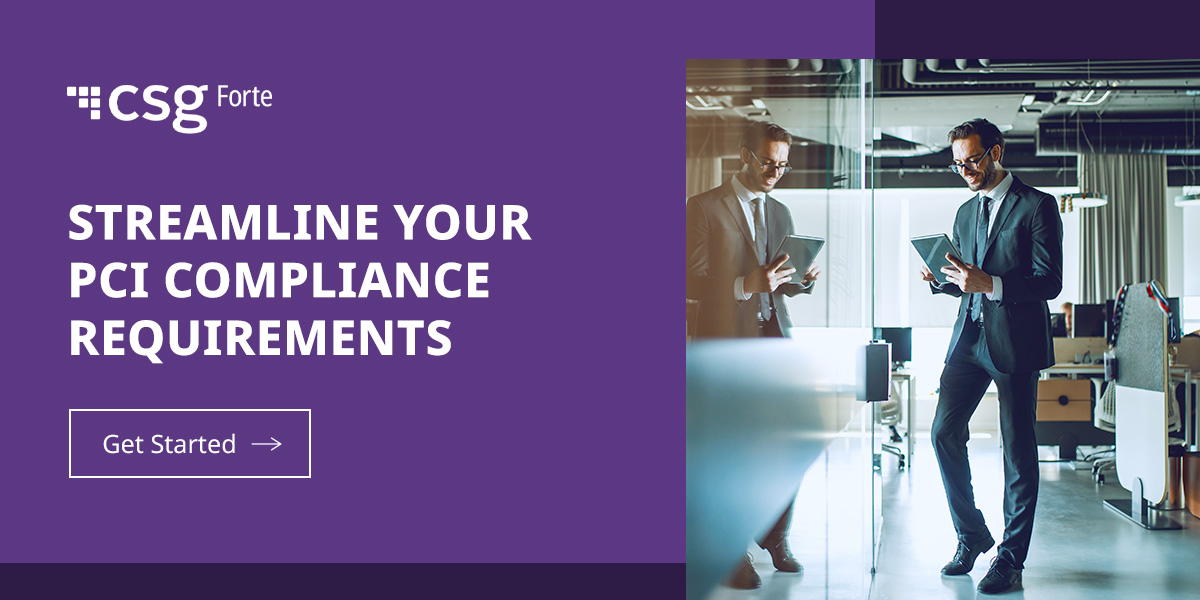PCI Compliance Guide
Payment card industry (PCI) compliance is the global security standard for organizations that accept consumer credit card payments. Being PCI compliant entails adhering to a variety of best practices, security measures and benchmarks that determine how you collect and store customer information while processing transactions. Let’s break down what you need to know about PCI compliance and its primary benefits. We’ll also outline how your organization can streamline the process of achieving PCI compliance.
What Are PCI Standards and Compliance?
PCI compliance comprises the technical and operational requirements your business needs to follow to protect consumer credit card data. It’s a comprehensive set of policies ranging from regular system upkeep to clearly delineated user permissions.
The PCI Security Standards Council develops and manages compliance standards to help organizations fortify their security systems and prioritize consumer data protection.
PCI compliance requirements include:
- Security against malicious software
- Routine network maintenance
- Cardholder data encryption
- Restricted internal access to sensitive data
PCI Credit Card Compliance Overview
PCI compliance may seem challenging if you are unfamiliar with the terminology or the latest cybersecurity best practices. But you don’t have to figure it out alone. You can achieve compliance and minimize risk by partnering with a trusted, experienced payment service provider. The PCI Security Standards Council provides a list of approved Qualified Security Assessors (QSA) companies you can reference for easier navigation. Still, it is valuable for your business to grasp the fundamentals of PCI compliance. Here is an overview to get a better understanding:
- It’s a continuous exercise: PCI compliance is an ongoing process that your organization should review yearly.
- Your payment methods have an impact: The type of payment services you offer can affect the amount of work you need to do to remain compliant.
- Requirements vary: Your compliance requirements depend on the size of your organization and the number of card payments you process annually.
- Your transaction count matters: PCI compliance rules sort businesses into several groups. Level-one merchants have the most requirements to meet because they process over six million annual transactions across channels. Smaller organizations will have fewer transactions, and therefore fewer rules to follow.
- Merchant account providers may add requirements: To accept credit card payments, you need a merchant account and service provider. If you have a merchant account, your payment service provider should have PCI compliance-related requirements included in the terms and conditions of your agreement.
The Primary Goals of PCI Compliance
The principles that guide the 12 PCI requirements can be summarized in six main goals:
- Build and maintain a secure network and systems: Use strong passwords, firewalls and/or software security technology to protect your network from hackers.
- Protect account data: Keep your customers’ data safer with encryption, tokenization and other ways to disguise sensitive information.
- Maintain a vulnerability management program: Establish a vulnerability management program that helps protect your organization from malware.
- Implement strong access control measures: Restrict which employees can access cardholder information. Ensure limited users have access in person and online.
- Regularly monitor and test networks: Test your networks regularly and track who is accessing cardholder data.
- Maintain an information security policy: Your staff must be familiar with internal procedures and regulations regarding cardholder data.
The 6 Compliance Groups for PCI DSS
Organizations that must adhere to the PCI Data Security Standard (DSS) fall into one of six categories. These categories depict the organizations’ level of involvement in card data handling and conducting card transactions. The six groups are:
- Merchants: Businesses that directly accept customer card payments are merchants. All merchant organizations must comply with PCI standards to prevent security breaches and protect cardholder information. Merchants must ensure secure card environments, including those related to data transmission, physical security and access control measures.
- Service providers: Entities that transmit, store or process data on a merchant’s behalf are service providers. These organizations may include security service companies, payment gateways or hosting providers. Organizations in this category must demonstrate compliance to merchants and adhere to PCI DSS.
- Qualifies Security Assessors: QSAs are independent entities that assess service provider and merchant compliance with PCI DSS. These organizations verify security measures and their effectiveness.
- Internal Security Assessors (ISAs): ISAs refer to internal employees of PCI Security Standards Council-certified organizations who have the training to assess and validate organizational procedures, policies and security controls.
- Payment card brands: Major credit card companies, including Mastercard, American Express and Visa, fall into this category. These entities establish the guidelines and security requirements for protecting cardholder information. They can impose penalties, such as fines, on merchants that fail to adhere to standards or practice malicious compliance.
- Acquiring banks: Financial institutions that craft agreements with merchants to process card transactions are considered acquiring banks. These organizations aim to ensure merchant compliance with PCI DSS to minimize fraudulent activity and similar adverse outcomes that could tarnish the organization’s brand or reputation. Some acquiring banks require merchants to undergo regular security audits or provide compliance evidence to ensure ongoing standard adherence and best practices.
12 Requirements for PCI Compliance
The PCI Security Standards Council provides 12 requirements for businesses to be compliant. Here is an overview of the PCI DSS requirements:
Goal: Build and Maintain a Secure Network and Systems
- Install and maintain network security controls: Install and update a network security device or software-defined technologies that check traffic entering and exiting your network, identifying and blocking potential cyber threats. Test your networks and control connections to untrusted networks.
- Apply secure configurations to all system components: You must define and implement processes and mechanisms that ensure the secure configuration and management of system components. For instance, you may do this by changing vendor-supplied passwords, restricting generic settings, removing functionality where necessary, encrypting access or enabling only essential services.
Goal: Protect Account Data
- Safeguard stored account data: Protect payment data. Implement policies for disposing of cardholder data, avoid storing sensitive data and limit what you keep, which should be strictly what is necessary for the needs of the business.
- Protect cardholder data with strong cryptography during transmission over open, public networks: Do not send unprotected account numbers (PAN) and sensitive personal information by any end-user communication technology. Instead, use strong cryptography.
Goal: Maintain a Vulnerability Management Program
- Protect all systems and networks from malicious software: Put mechanisms and processes in place to protect your networks and systems from malicious software and malware. Equip your staff with mechanisms to protect them from phishing attacks.
- Develop and maintain secure systems and software: Spend time reviewing vulnerabilities and risks, then implement processes and systems to provide protection, including following secure development and coding practices.
Goal: Implement Strong Access Control Measures
- Restrict access to cardholder data by business need-to-know: Restrict cardholder data to only users who need to use the information to complete transactions. Define access roles, privileges and controls so only authorized users can access data.
- Identify users and authenticate access to system components: Authenticate users and document policies, and see that each user has unique, identifying credentials. For a production environment where you store account data, you must implement multi-factor authentication.
- Restrict physical access to cardholder data: Mechanisms to restrict access to cardholder data must be in place. For instance point-of-sale devices must have protection from tampering or non-authorized substitution.
Goal: Regularly Monitor and Test Networks
- Log and monitor all access to system components and cardholder data: Ensure your system has an audit trail, and leverage time-stamped tracking tools. These tools can show you when employees access data and help you review logs and identify suspicious activity.
- Test security of systems and networks regularly: Test and catalog wireless access points. Schedule frequent security vulnerability assessments and proactively monitor traffic.
Goal: Maintain an Information Security Policy
- Support information security with organizational policies and programs: Establish, publish, and share your company’s information security policy. Explicitly state rules for technologies, key responsibilities and best practices. Give new employees the policy once they sign on. Consider that education on security awareness must be an ongoing activity.

Payment service providers help you manage PCI compliance, making the 12 requirements and six goals simple for you to oversee. Robust platforms will have many of the rules built in, automating the process. The bottom line is that you do not have to go at it alone.
Note on PCI DSS V4.0
March 2024 marked the beginning of PCI DSS version 4.0 application. Full implementation of PCI 4.0 requirements became effective in March 2025. The latest version of the standard includes many changes that you can check here. A summary of some of the reasons for the changes comprise:
- Evolution of security needs: As threats evolve, security practices must evolve as well. That is why PCI DSS V4.0 includes requirements for multi-factor authentication, password updates and e-commerce and anti-phishing.
- Security promotion as a continuous process: To face ever-changing malicious conducts, you need to keep a recurring, well-defined and strong policy and processes.
- Increase flexibility to achieve security objectives: Your organization may adopt an innovative or different approach to achieve some objectives while maintaining strict controls and processes and keeping the security objectives at the core of your planning and execution.
- Enhance procedures and validation methods: Achieve transparency and granularity by designing for clear validation and aligned reports.
How to Achieve PCI Compliance
To become PCI compliant, you need to meet the requirements, do an assessment and complete a security scan:
- Meet the requirements: Your organization must comply with the PCI Security Council’s rules and any amendments to provisions and sub-requirements.
- Complete an evaluation: Your organization should complete an assessment showing your security systems and measures to safeguard consumer information. Smaller organizations may complete a self-assessment. Larger enterprises must use third-party auditors to assist.
- Perform a security scan: Your organization must scan the network you use to process payments. The scan is highly specialized and technical and benefits from expert assistance from an independent firm.
Organizational PCI Levels of Compliance
For PCI compliance, your organization must undergo a rigorous annual assessment. Although the requirements are universal, your business may need to adhere to additional rules and undergo more stringent checks. Depending on the size of your organization and the amount of transactions you process annually, you will fall into four main categories:
- Level-one organizations: If you process more than six million Visa payments annually across various channels, you fall into level one. You will have the most robust assessments and rules you must adhere to.
- Level-two organizations: Level two organizations complete between one and six million Visa transactions yearly.
- Level-three organizations: If you process between 20,000 and one million Visa payments every year, you fall into level three.
- Level-four organizations: Level four organizations process under 20,000 Visa transactions each year.
PCI Security Standards Council may move organizations that have experienced a cyberattack resulting in data loss into a higher validation level—regardless of the yearly transaction amounts.
The Benefits of Credit Card PCI Compliance
Your organization benefits from continuously evaluating and maintaining your security systems and addressing gaps. Other benefits of being PCI compliant include:
- Minimizing the risk of data breaches
- Protecting cardholder data
- Reducing the risk of consumer identity theft
- Identifying, monitoring and addressing security vulnerabilities
- Decreasing the risk of paying fines associated with data breaches
- Safeguarding your organization’s reputation
- Keeping customers happy and confident when transacting with you
Frequently Asked Questions About Credit Card Compliance
Have more questions? Here, we’ve answered some frequently asked questions about PCI compliance and related terms or processes.
1. Who Must Be PCI Compliant?
If your organization accepts, transmits or stores cardholders’ personal data, you must be PCI compliant.
2. What Does PCI Compliance Mean?
PCI compliance means that your organization meets the various security requirements that the PCI Security Standards Council provides. Meeting this compliance means the way your organization accepts, transmits and stores data is safe, private and secure according to the PCI mandate.
3. What Is the Definition of Malicious Compliance?
Malicious compliance, when relating to PCI, refers to situations in which a company appears to adhere to PCI standards but intentionally implements strategies with minimal effectiveness. Organizations that practice malicious compliance often leave significant vulnerabilities. These attempts to appear compliant without truly securing sensitive information aim to deceive customers, clients and entities.
Examples of malicious compliance could include weak encryption, non-functional security controls or insufficient access controls. Organizations practicing malicious compliance could face severe penalties.
4. Is PCI Compliance Required by Law?
PCI Security Standard Council monitors the implementation of standards. PCI SSC standard is at the discretion of organizations that manage compliance programs, such as a payment brand, acquirer or other entities.
5. How Do I Become PCI-Compliant?
PCI compliance is achieved by completing a self-assessment questionnaire (SAQ) or hiring an approved vendor third-party auditor to complete the assessment, CSG Partners with Aperia, a QSA Approved Vendor. Upon completing the SAQ and vulnerability scan (if applicable), submit all documentation and evidence to your payment processor (CSG Forte).
6. What Are Examples of PCI Compliance and Data Breaches?
When there are large PCI violations and data breaches it is often newsworthy. The sheer volume of the data and the high profile of the companies involved make these events prominent in the public eye, harming brands’ reputations and exposing millions of consumers to theft and identity fraud. However, it’s key to remember that cybercriminals target companies of all sizes and industries and no business is immune.
7. What Can My Business Do to Simplify PCI Compliance?
Although the technical aspects of completing the PCI assessment may be beyond the scope of what you can do yourself, your organization can take steps to make the process easier. Focusing on data hygiene is a good example. Here is a PCI compliance checklist:
- Ensure your organization uses strong passwords and has strict protocols to enforce this.
- Keep your software updated.
- Only store the data you need.
- Be wary of links—encourage employees to think twice before clicking on suspicious links.
- Explain to employees the importance of protecting consumer data and the implications of not doing so.
Meet PCI Requirements With CSG Forte
Boost your payment security and protect customers’ sensitive data with CSG Forte’s secure payment solutions. Leverage the industry’s highest security standards with a platform with built-in PCI compliance mandates. CSG Forte provides:
- Secure payments: Keep your consumer data safe with every transaction with CSG Forte’s advanced technology standards and protocols.
- Tokenization: Leverage randomly generated tokens with no intrinsic value to replace cards, automated clearing house (ACH) networks and other sensitive data. Tokenization helps your organization safeguard against digital security breaches.
- End-to-end encryption: Using PCI-validated end-to-end encryption, you can disguise credit card data during transmission. The encryption ensures card data is valueless if intercepted.
- Hosted payment pages: Make sure your organization never stores data in your system using hosted payment pages (HPPs) or external checkout pages. CSG’s platform enables you to provide secure checkouts that won’t require you to manage and collect sensitive data during transactions. Third-party checkout is the easiest, most popular and safest way to accept online payments.
- Adherence to compliance standards: Benefit from adhering to the most robust, reliable and up-to-date compliance programs. CSG’s security and compliance experts focus on delivering solutions in compliance with various mandates. We hold ISO 27001:2013 certification and maintain PCI DSS v3.2.1 compliance and Health Insurance Portability and Accountability Act (HIPAA) compliance. We deliver SSAE 18 / ISAE 3402 SOC 1 Type II reports to ensure your organization’s credibility, accuracy and system security in safeguarding consumer data.
Streamline Your PCI Compliance Requirements
Protect consumer data and prioritize security by leveraging CSG Forte’s award-winning payment platform. Our easy-to-integrate and navigate solution streamlines your payments, helping you process your transactions in one place.
Meet PCI compliance requirements with our built-in functionalities and tools, simplifying secure transactions. Build consumer trust and have peace of mind knowing your payment systems are robust and leveraging the latest security technology.
For over two decades and counting, CSG Forte has been helping thousands of government, insurance, telecom and other industry merchants optimize security, scale their business and process omnichannel payments efficiently.
Whether you are a new merchant or an existing merchant, we can help you achieving PCI compliance and get the support you need to ensure processing payments is a frictionless endeavor. Contact our team.


